University Essay: Australian Society, Systems, and Policies Analysis
VerifiedAdded on 2021/05/31
|9
|1747
|105
Essay
AI Summary
This essay provides a comprehensive overview of Australian society, examining its historical development, cultural diversity, and social policies. It begins with a brief history of Australia, highlighting its origins as a British penal colony and the impact of immigration on shaping its national identity. The essay then delves into the key aspects of Australian culture, including the influence of British traditions, Aboriginal heritage, and multiculturalism. It explores the social values and norms that define Australian society, such as egalitarianism and informality. The discussion covers the impact of immigration, the adoption of multiculturalism, and the diverse languages and religions practiced in Australia. The essay also examines the legal and policy frameworks that address issues of human rights, disability, and indigenous communities. It highlights the role of government policies, such as the National Strategy and mental health initiatives, in promoting social inclusion and well-being. Finally, the essay touches upon the traditions and customs of Australian society, including gift-giving, celebrations, and the role of religious institutions. Overall, the essay provides a detailed analysis of the complex and evolving nature of Australian society.
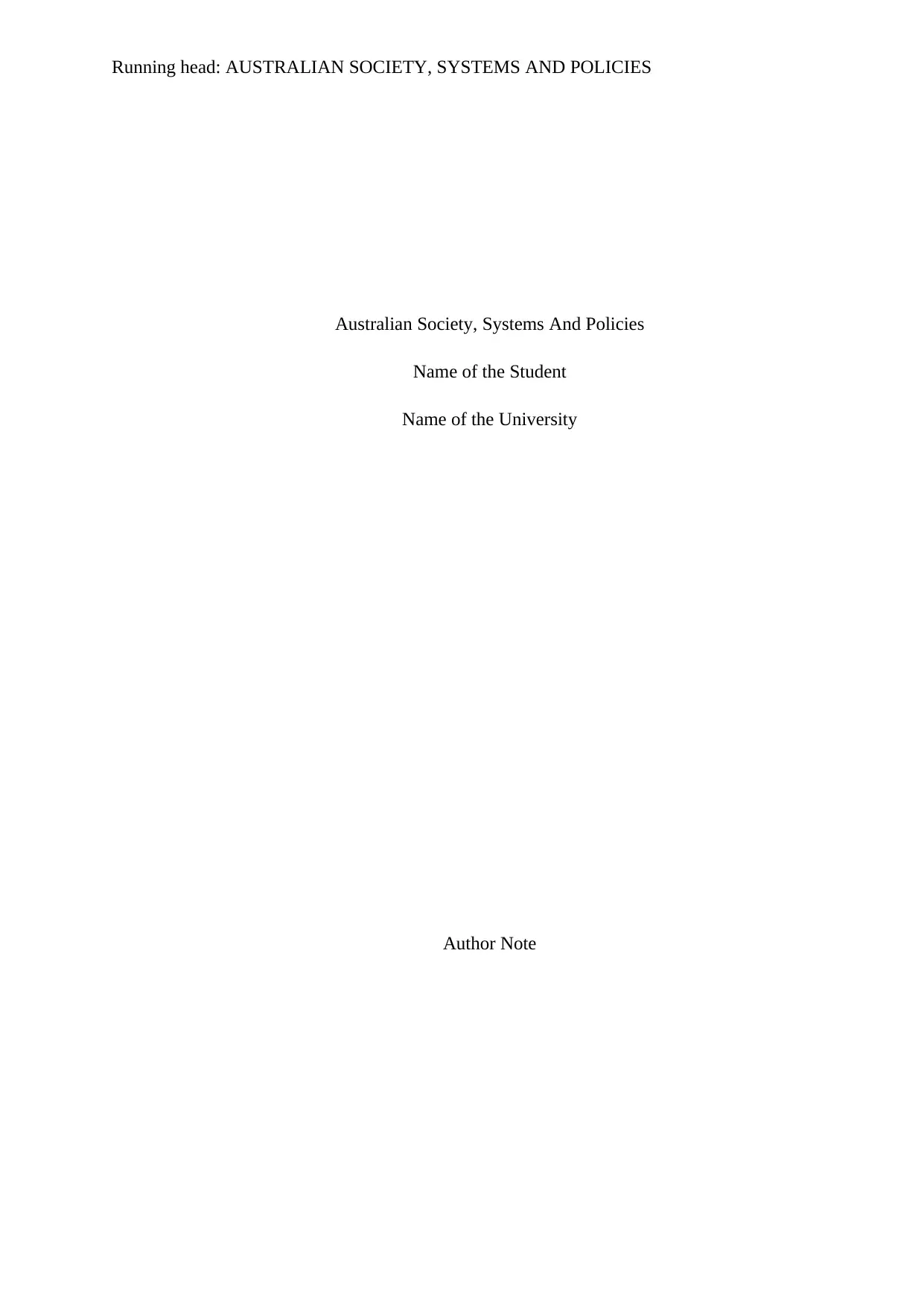
Running head: AUSTRALIAN SOCIETY, SYSTEMS AND POLICIES
Australian Society, Systems And Policies
Name of the Student
Name of the University
Author Note
Australian Society, Systems And Policies
Name of the Student
Name of the University
Author Note
Paraphrase This Document
Need a fresh take? Get an instant paraphrase of this document with our AI Paraphraser
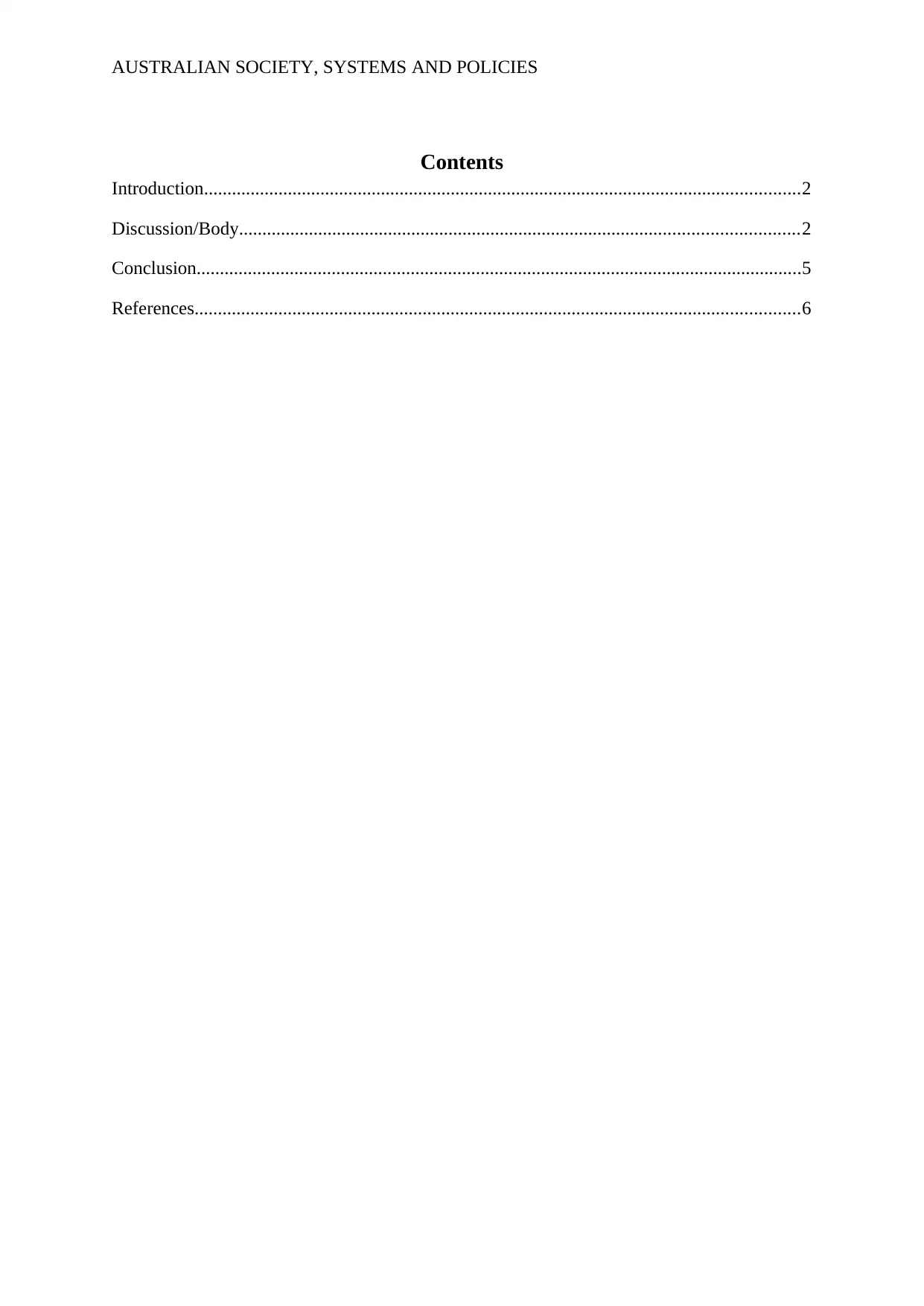
AUSTRALIAN SOCIETY, SYSTEMS AND POLICIES
Contents
Introduction................................................................................................................................2
Discussion/Body........................................................................................................................2
Conclusion..................................................................................................................................5
References..................................................................................................................................6
Contents
Introduction................................................................................................................................2
Discussion/Body........................................................................................................................2
Conclusion..................................................................................................................................5
References..................................................................................................................................6
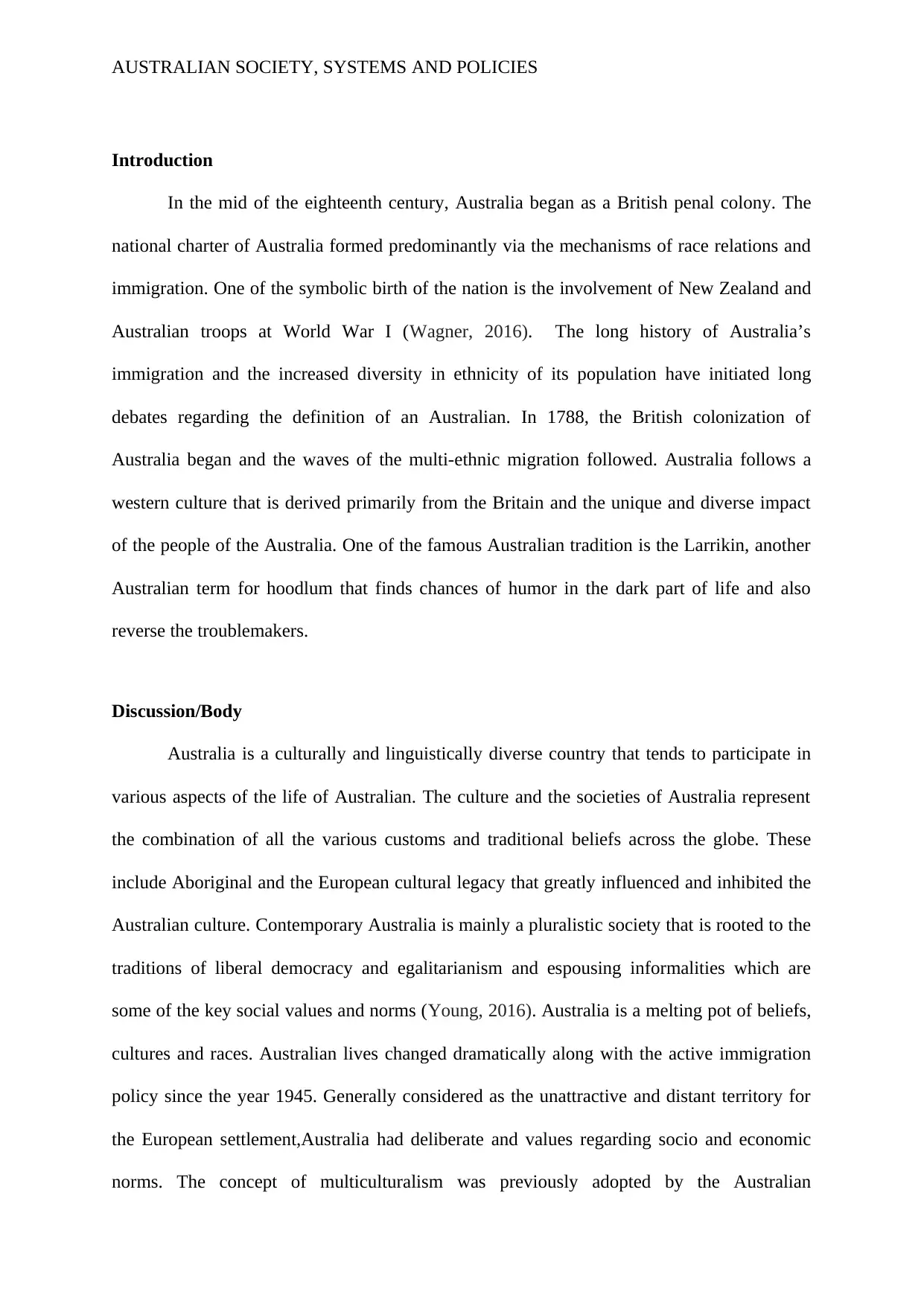
AUSTRALIAN SOCIETY, SYSTEMS AND POLICIES
Introduction
In the mid of the eighteenth century, Australia began as a British penal colony. The
national charter of Australia formed predominantly via the mechanisms of race relations and
immigration. One of the symbolic birth of the nation is the involvement of New Zealand and
Australian troops at World War I (Wagner, 2016). The long history of Australia’s
immigration and the increased diversity in ethnicity of its population have initiated long
debates regarding the definition of an Australian. In 1788, the British colonization of
Australia began and the waves of the multi-ethnic migration followed. Australia follows a
western culture that is derived primarily from the Britain and the unique and diverse impact
of the people of the Australia. One of the famous Australian tradition is the Larrikin, another
Australian term for hoodlum that finds chances of humor in the dark part of life and also
reverse the troublemakers.
Discussion/Body
Australia is a culturally and linguistically diverse country that tends to participate in
various aspects of the life of Australian. The culture and the societies of Australia represent
the combination of all the various customs and traditional beliefs across the globe. These
include Aboriginal and the European cultural legacy that greatly influenced and inhibited the
Australian culture. Contemporary Australia is mainly a pluralistic society that is rooted to the
traditions of liberal democracy and egalitarianism and espousing informalities which are
some of the key social values and norms (Young, 2016). Australia is a melting pot of beliefs,
cultures and races. Australian lives changed dramatically along with the active immigration
policy since the year 1945. Generally considered as the unattractive and distant territory for
the European settlement,Australia had deliberate and values regarding socio and economic
norms. The concept of multiculturalism was previously adopted by the Australian
Introduction
In the mid of the eighteenth century, Australia began as a British penal colony. The
national charter of Australia formed predominantly via the mechanisms of race relations and
immigration. One of the symbolic birth of the nation is the involvement of New Zealand and
Australian troops at World War I (Wagner, 2016). The long history of Australia’s
immigration and the increased diversity in ethnicity of its population have initiated long
debates regarding the definition of an Australian. In 1788, the British colonization of
Australia began and the waves of the multi-ethnic migration followed. Australia follows a
western culture that is derived primarily from the Britain and the unique and diverse impact
of the people of the Australia. One of the famous Australian tradition is the Larrikin, another
Australian term for hoodlum that finds chances of humor in the dark part of life and also
reverse the troublemakers.
Discussion/Body
Australia is a culturally and linguistically diverse country that tends to participate in
various aspects of the life of Australian. The culture and the societies of Australia represent
the combination of all the various customs and traditional beliefs across the globe. These
include Aboriginal and the European cultural legacy that greatly influenced and inhibited the
Australian culture. Contemporary Australia is mainly a pluralistic society that is rooted to the
traditions of liberal democracy and egalitarianism and espousing informalities which are
some of the key social values and norms (Young, 2016). Australia is a melting pot of beliefs,
cultures and races. Australian lives changed dramatically along with the active immigration
policy since the year 1945. Generally considered as the unattractive and distant territory for
the European settlement,Australia had deliberate and values regarding socio and economic
norms. The concept of multiculturalism was previously adopted by the Australian
⊘ This is a preview!⊘
Do you want full access?
Subscribe today to unlock all pages.

Trusted by 1+ million students worldwide
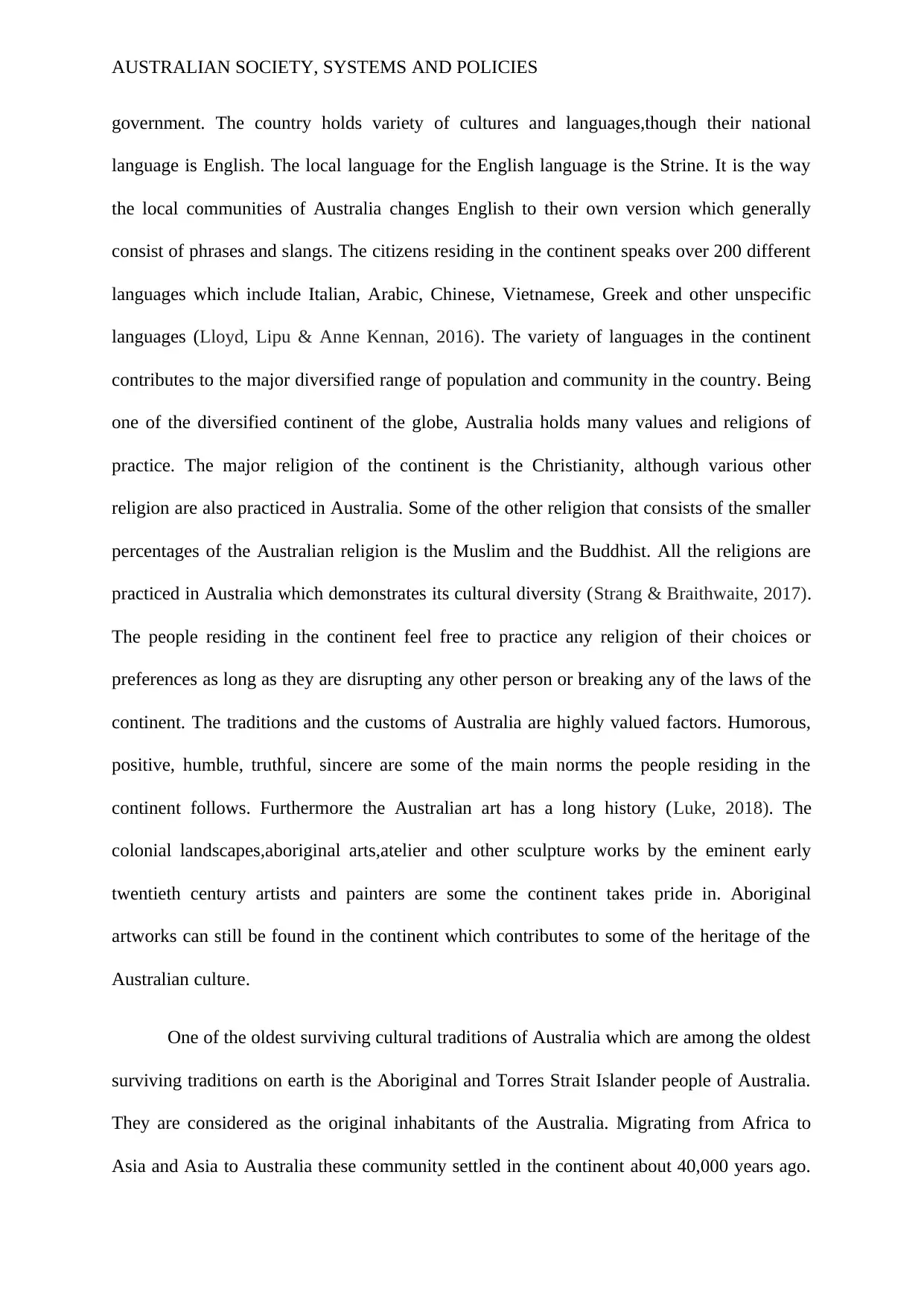
AUSTRALIAN SOCIETY, SYSTEMS AND POLICIES
government. The country holds variety of cultures and languages,though their national
language is English. The local language for the English language is the Strine. It is the way
the local communities of Australia changes English to their own version which generally
consist of phrases and slangs. The citizens residing in the continent speaks over 200 different
languages which include Italian, Arabic, Chinese, Vietnamese, Greek and other unspecific
languages (Lloyd, Lipu & Anne Kennan, 2016). The variety of languages in the continent
contributes to the major diversified range of population and community in the country. Being
one of the diversified continent of the globe, Australia holds many values and religions of
practice. The major religion of the continent is the Christianity, although various other
religion are also practiced in Australia. Some of the other religion that consists of the smaller
percentages of the Australian religion is the Muslim and the Buddhist. All the religions are
practiced in Australia which demonstrates its cultural diversity (Strang & Braithwaite, 2017).
The people residing in the continent feel free to practice any religion of their choices or
preferences as long as they are disrupting any other person or breaking any of the laws of the
continent. The traditions and the customs of Australia are highly valued factors. Humorous,
positive, humble, truthful, sincere are some of the main norms the people residing in the
continent follows. Furthermore the Australian art has a long history (Luke, 2018). The
colonial landscapes,aboriginal arts,atelier and other sculpture works by the eminent early
twentieth century artists and painters are some the continent takes pride in. Aboriginal
artworks can still be found in the continent which contributes to some of the heritage of the
Australian culture.
One of the oldest surviving cultural traditions of Australia which are among the oldest
surviving traditions on earth is the Aboriginal and Torres Strait Islander people of Australia.
They are considered as the original inhabitants of the Australia. Migrating from Africa to
Asia and Asia to Australia these community settled in the continent about 40,000 years ago.
government. The country holds variety of cultures and languages,though their national
language is English. The local language for the English language is the Strine. It is the way
the local communities of Australia changes English to their own version which generally
consist of phrases and slangs. The citizens residing in the continent speaks over 200 different
languages which include Italian, Arabic, Chinese, Vietnamese, Greek and other unspecific
languages (Lloyd, Lipu & Anne Kennan, 2016). The variety of languages in the continent
contributes to the major diversified range of population and community in the country. Being
one of the diversified continent of the globe, Australia holds many values and religions of
practice. The major religion of the continent is the Christianity, although various other
religion are also practiced in Australia. Some of the other religion that consists of the smaller
percentages of the Australian religion is the Muslim and the Buddhist. All the religions are
practiced in Australia which demonstrates its cultural diversity (Strang & Braithwaite, 2017).
The people residing in the continent feel free to practice any religion of their choices or
preferences as long as they are disrupting any other person or breaking any of the laws of the
continent. The traditions and the customs of Australia are highly valued factors. Humorous,
positive, humble, truthful, sincere are some of the main norms the people residing in the
continent follows. Furthermore the Australian art has a long history (Luke, 2018). The
colonial landscapes,aboriginal arts,atelier and other sculpture works by the eminent early
twentieth century artists and painters are some the continent takes pride in. Aboriginal
artworks can still be found in the continent which contributes to some of the heritage of the
Australian culture.
One of the oldest surviving cultural traditions of Australia which are among the oldest
surviving traditions on earth is the Aboriginal and Torres Strait Islander people of Australia.
They are considered as the original inhabitants of the Australia. Migrating from Africa to
Asia and Asia to Australia these community settled in the continent about 40,000 years ago.
Paraphrase This Document
Need a fresh take? Get an instant paraphrase of this document with our AI Paraphraser
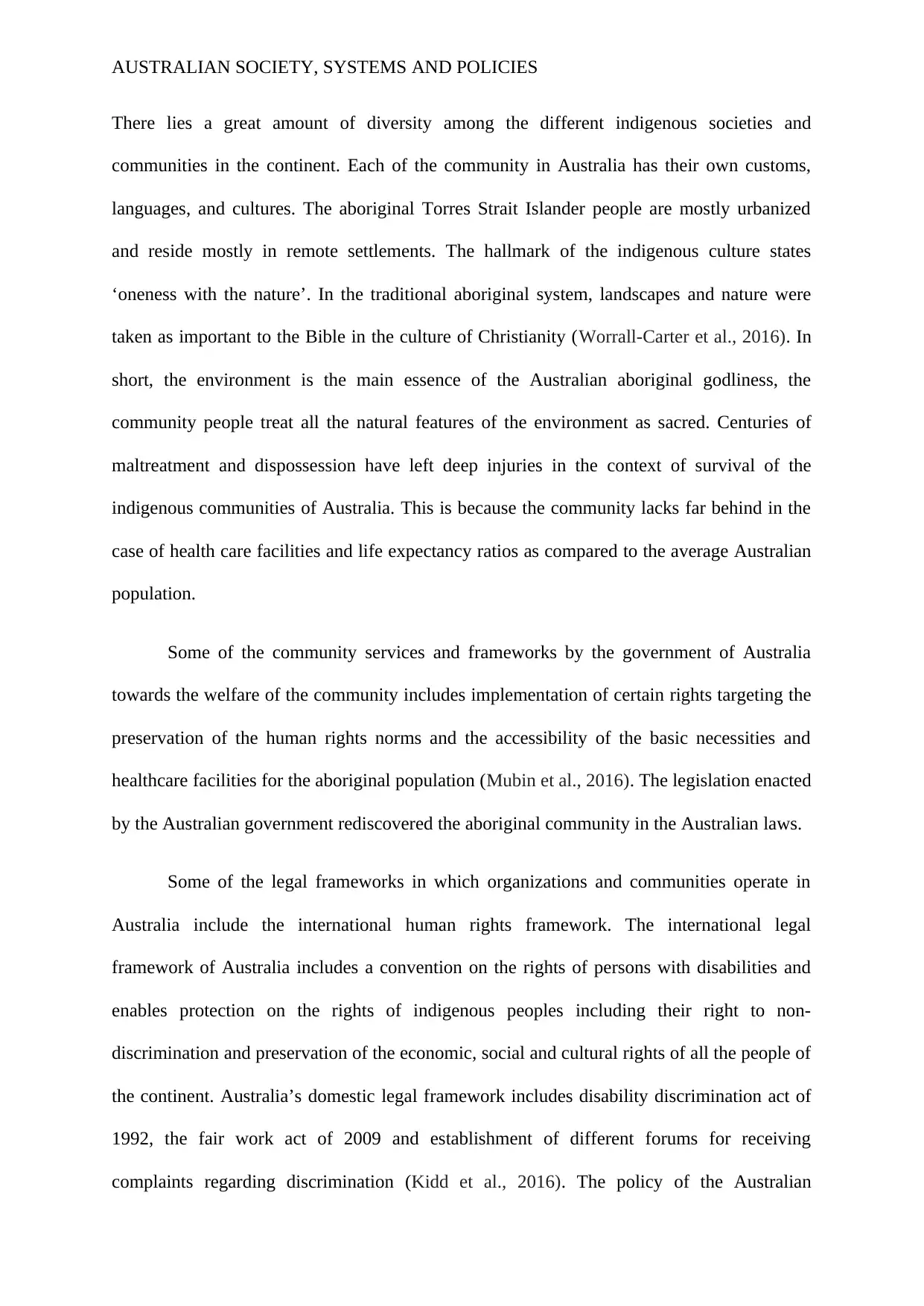
AUSTRALIAN SOCIETY, SYSTEMS AND POLICIES
There lies a great amount of diversity among the different indigenous societies and
communities in the continent. Each of the community in Australia has their own customs,
languages, and cultures. The aboriginal Torres Strait Islander people are mostly urbanized
and reside mostly in remote settlements. The hallmark of the indigenous culture states
‘oneness with the nature’. In the traditional aboriginal system, landscapes and nature were
taken as important to the Bible in the culture of Christianity (Worrall-Carter et al., 2016). In
short, the environment is the main essence of the Australian aboriginal godliness, the
community people treat all the natural features of the environment as sacred. Centuries of
maltreatment and dispossession have left deep injuries in the context of survival of the
indigenous communities of Australia. This is because the community lacks far behind in the
case of health care facilities and life expectancy ratios as compared to the average Australian
population.
Some of the community services and frameworks by the government of Australia
towards the welfare of the community includes implementation of certain rights targeting the
preservation of the human rights norms and the accessibility of the basic necessities and
healthcare facilities for the aboriginal population (Mubin et al., 2016). The legislation enacted
by the Australian government rediscovered the aboriginal community in the Australian laws.
Some of the legal frameworks in which organizations and communities operate in
Australia include the international human rights framework. The international legal
framework of Australia includes a convention on the rights of persons with disabilities and
enables protection on the rights of indigenous peoples including their right to non-
discrimination and preservation of the economic, social and cultural rights of all the people of
the continent. Australia’s domestic legal framework includes disability discrimination act of
1992, the fair work act of 2009 and establishment of different forums for receiving
complaints regarding discrimination (Kidd et al., 2016). The policy of the Australian
There lies a great amount of diversity among the different indigenous societies and
communities in the continent. Each of the community in Australia has their own customs,
languages, and cultures. The aboriginal Torres Strait Islander people are mostly urbanized
and reside mostly in remote settlements. The hallmark of the indigenous culture states
‘oneness with the nature’. In the traditional aboriginal system, landscapes and nature were
taken as important to the Bible in the culture of Christianity (Worrall-Carter et al., 2016). In
short, the environment is the main essence of the Australian aboriginal godliness, the
community people treat all the natural features of the environment as sacred. Centuries of
maltreatment and dispossession have left deep injuries in the context of survival of the
indigenous communities of Australia. This is because the community lacks far behind in the
case of health care facilities and life expectancy ratios as compared to the average Australian
population.
Some of the community services and frameworks by the government of Australia
towards the welfare of the community includes implementation of certain rights targeting the
preservation of the human rights norms and the accessibility of the basic necessities and
healthcare facilities for the aboriginal population (Mubin et al., 2016). The legislation enacted
by the Australian government rediscovered the aboriginal community in the Australian laws.
Some of the legal frameworks in which organizations and communities operate in
Australia include the international human rights framework. The international legal
framework of Australia includes a convention on the rights of persons with disabilities and
enables protection on the rights of indigenous peoples including their right to non-
discrimination and preservation of the economic, social and cultural rights of all the people of
the continent. Australia’s domestic legal framework includes disability discrimination act of
1992, the fair work act of 2009 and establishment of different forums for receiving
complaints regarding discrimination (Kidd et al., 2016). The policy of the Australian
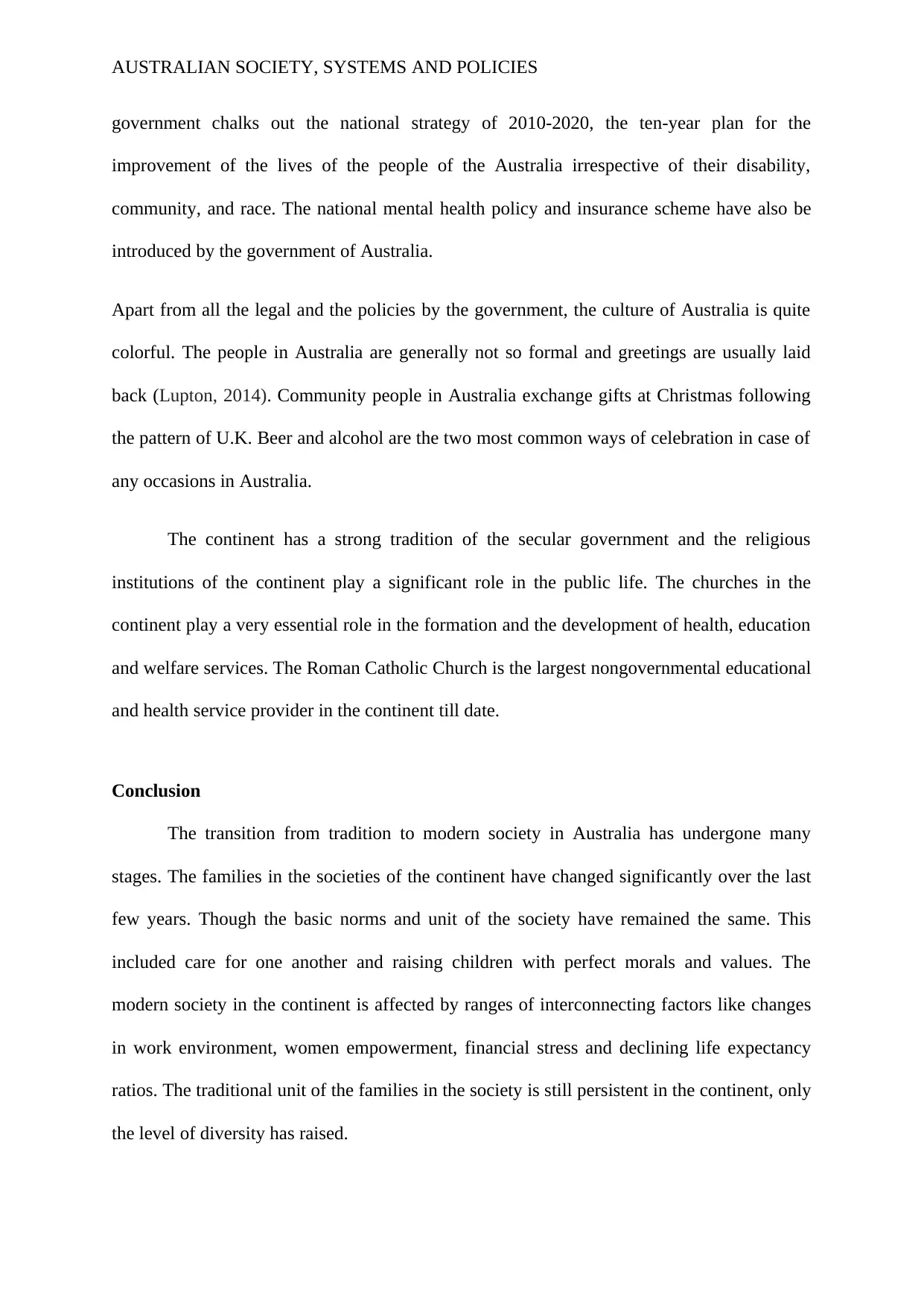
AUSTRALIAN SOCIETY, SYSTEMS AND POLICIES
government chalks out the national strategy of 2010-2020, the ten-year plan for the
improvement of the lives of the people of the Australia irrespective of their disability,
community, and race. The national mental health policy and insurance scheme have also be
introduced by the government of Australia.
Apart from all the legal and the policies by the government, the culture of Australia is quite
colorful. The people in Australia are generally not so formal and greetings are usually laid
back (Lupton, 2014). Community people in Australia exchange gifts at Christmas following
the pattern of U.K. Beer and alcohol are the two most common ways of celebration in case of
any occasions in Australia.
The continent has a strong tradition of the secular government and the religious
institutions of the continent play a significant role in the public life. The churches in the
continent play a very essential role in the formation and the development of health, education
and welfare services. The Roman Catholic Church is the largest nongovernmental educational
and health service provider in the continent till date.
Conclusion
The transition from tradition to modern society in Australia has undergone many
stages. The families in the societies of the continent have changed significantly over the last
few years. Though the basic norms and unit of the society have remained the same. This
included care for one another and raising children with perfect morals and values. The
modern society in the continent is affected by ranges of interconnecting factors like changes
in work environment, women empowerment, financial stress and declining life expectancy
ratios. The traditional unit of the families in the society is still persistent in the continent, only
the level of diversity has raised.
government chalks out the national strategy of 2010-2020, the ten-year plan for the
improvement of the lives of the people of the Australia irrespective of their disability,
community, and race. The national mental health policy and insurance scheme have also be
introduced by the government of Australia.
Apart from all the legal and the policies by the government, the culture of Australia is quite
colorful. The people in Australia are generally not so formal and greetings are usually laid
back (Lupton, 2014). Community people in Australia exchange gifts at Christmas following
the pattern of U.K. Beer and alcohol are the two most common ways of celebration in case of
any occasions in Australia.
The continent has a strong tradition of the secular government and the religious
institutions of the continent play a significant role in the public life. The churches in the
continent play a very essential role in the formation and the development of health, education
and welfare services. The Roman Catholic Church is the largest nongovernmental educational
and health service provider in the continent till date.
Conclusion
The transition from tradition to modern society in Australia has undergone many
stages. The families in the societies of the continent have changed significantly over the last
few years. Though the basic norms and unit of the society have remained the same. This
included care for one another and raising children with perfect morals and values. The
modern society in the continent is affected by ranges of interconnecting factors like changes
in work environment, women empowerment, financial stress and declining life expectancy
ratios. The traditional unit of the families in the society is still persistent in the continent, only
the level of diversity has raised.
⊘ This is a preview!⊘
Do you want full access?
Subscribe today to unlock all pages.

Trusted by 1+ million students worldwide
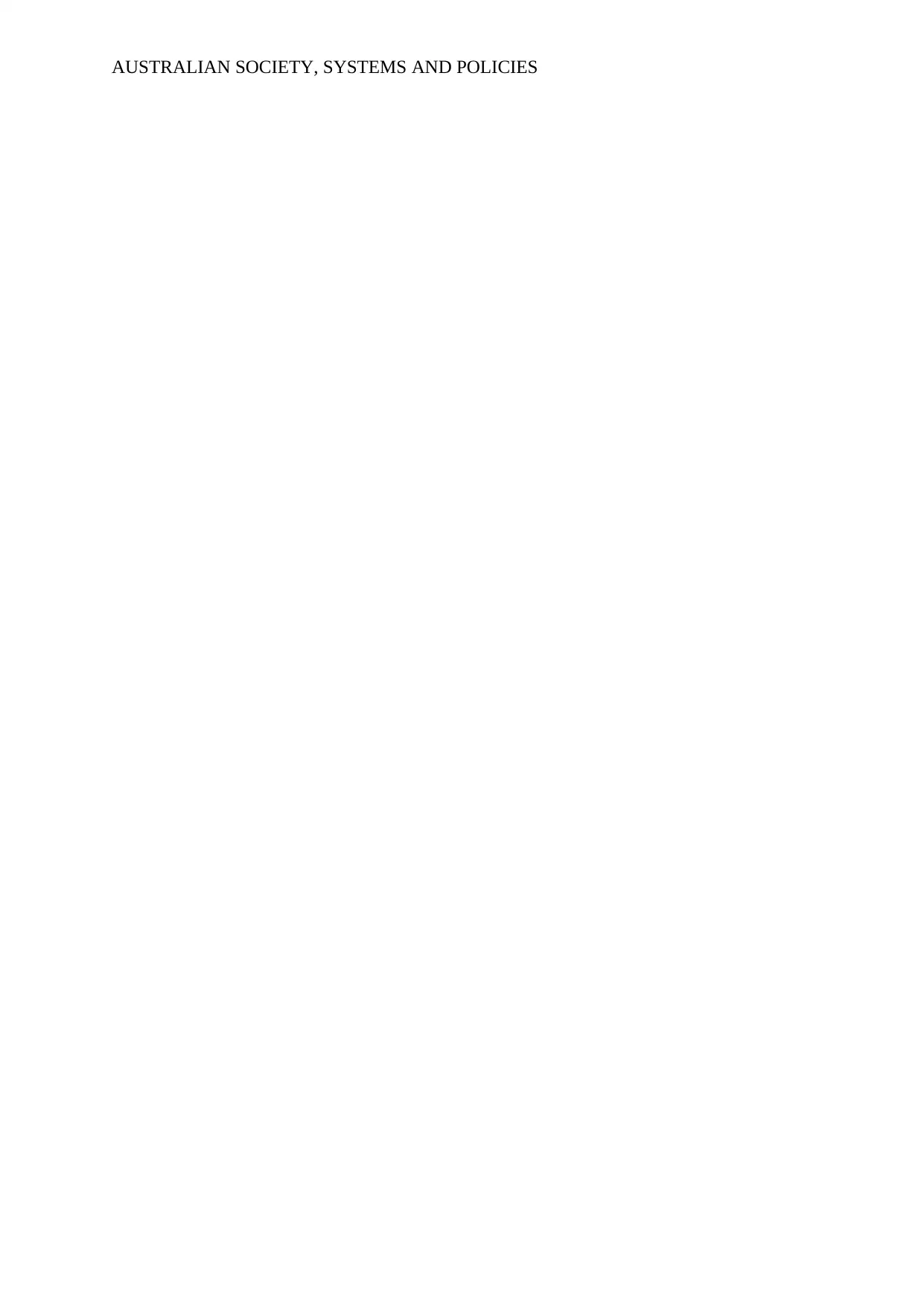
AUSTRALIAN SOCIETY, SYSTEMS AND POLICIES
Paraphrase This Document
Need a fresh take? Get an instant paraphrase of this document with our AI Paraphraser
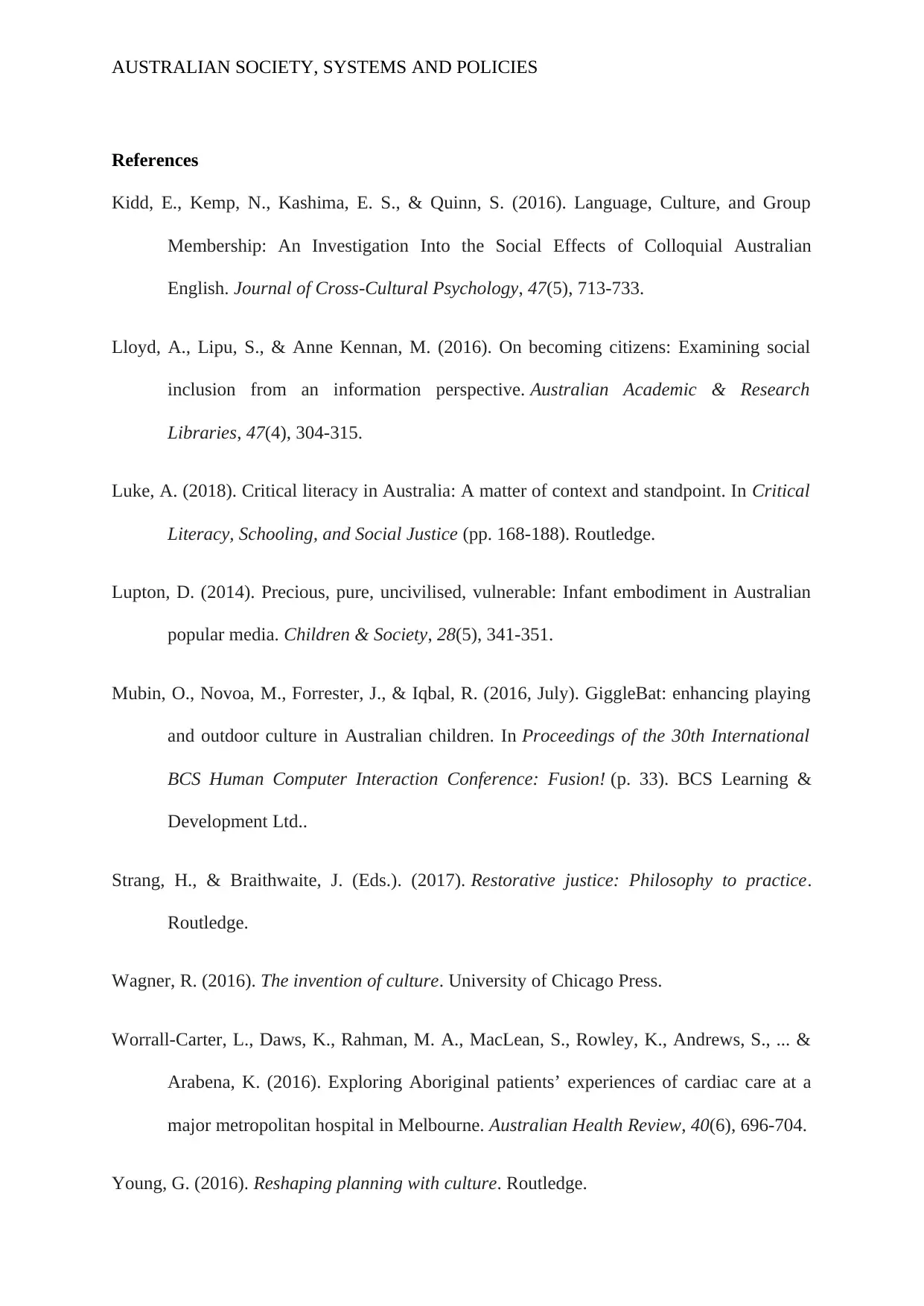
AUSTRALIAN SOCIETY, SYSTEMS AND POLICIES
References
Kidd, E., Kemp, N., Kashima, E. S., & Quinn, S. (2016). Language, Culture, and Group
Membership: An Investigation Into the Social Effects of Colloquial Australian
English. Journal of Cross-Cultural Psychology, 47(5), 713-733.
Lloyd, A., Lipu, S., & Anne Kennan, M. (2016). On becoming citizens: Examining social
inclusion from an information perspective. Australian Academic & Research
Libraries, 47(4), 304-315.
Luke, A. (2018). Critical literacy in Australia: A matter of context and standpoint. In Critical
Literacy, Schooling, and Social Justice (pp. 168-188). Routledge.
Lupton, D. (2014). Precious, pure, uncivilised, vulnerable: Infant embodiment in Australian
popular media. Children & Society, 28(5), 341-351.
Mubin, O., Novoa, M., Forrester, J., & Iqbal, R. (2016, July). GiggleBat: enhancing playing
and outdoor culture in Australian children. In Proceedings of the 30th International
BCS Human Computer Interaction Conference: Fusion! (p. 33). BCS Learning &
Development Ltd..
Strang, H., & Braithwaite, J. (Eds.). (2017). Restorative justice: Philosophy to practice.
Routledge.
Wagner, R. (2016). The invention of culture. University of Chicago Press.
Worrall-Carter, L., Daws, K., Rahman, M. A., MacLean, S., Rowley, K., Andrews, S., ... &
Arabena, K. (2016). Exploring Aboriginal patients’ experiences of cardiac care at a
major metropolitan hospital in Melbourne. Australian Health Review, 40(6), 696-704.
Young, G. (2016). Reshaping planning with culture. Routledge.
References
Kidd, E., Kemp, N., Kashima, E. S., & Quinn, S. (2016). Language, Culture, and Group
Membership: An Investigation Into the Social Effects of Colloquial Australian
English. Journal of Cross-Cultural Psychology, 47(5), 713-733.
Lloyd, A., Lipu, S., & Anne Kennan, M. (2016). On becoming citizens: Examining social
inclusion from an information perspective. Australian Academic & Research
Libraries, 47(4), 304-315.
Luke, A. (2018). Critical literacy in Australia: A matter of context and standpoint. In Critical
Literacy, Schooling, and Social Justice (pp. 168-188). Routledge.
Lupton, D. (2014). Precious, pure, uncivilised, vulnerable: Infant embodiment in Australian
popular media. Children & Society, 28(5), 341-351.
Mubin, O., Novoa, M., Forrester, J., & Iqbal, R. (2016, July). GiggleBat: enhancing playing
and outdoor culture in Australian children. In Proceedings of the 30th International
BCS Human Computer Interaction Conference: Fusion! (p. 33). BCS Learning &
Development Ltd..
Strang, H., & Braithwaite, J. (Eds.). (2017). Restorative justice: Philosophy to practice.
Routledge.
Wagner, R. (2016). The invention of culture. University of Chicago Press.
Worrall-Carter, L., Daws, K., Rahman, M. A., MacLean, S., Rowley, K., Andrews, S., ... &
Arabena, K. (2016). Exploring Aboriginal patients’ experiences of cardiac care at a
major metropolitan hospital in Melbourne. Australian Health Review, 40(6), 696-704.
Young, G. (2016). Reshaping planning with culture. Routledge.
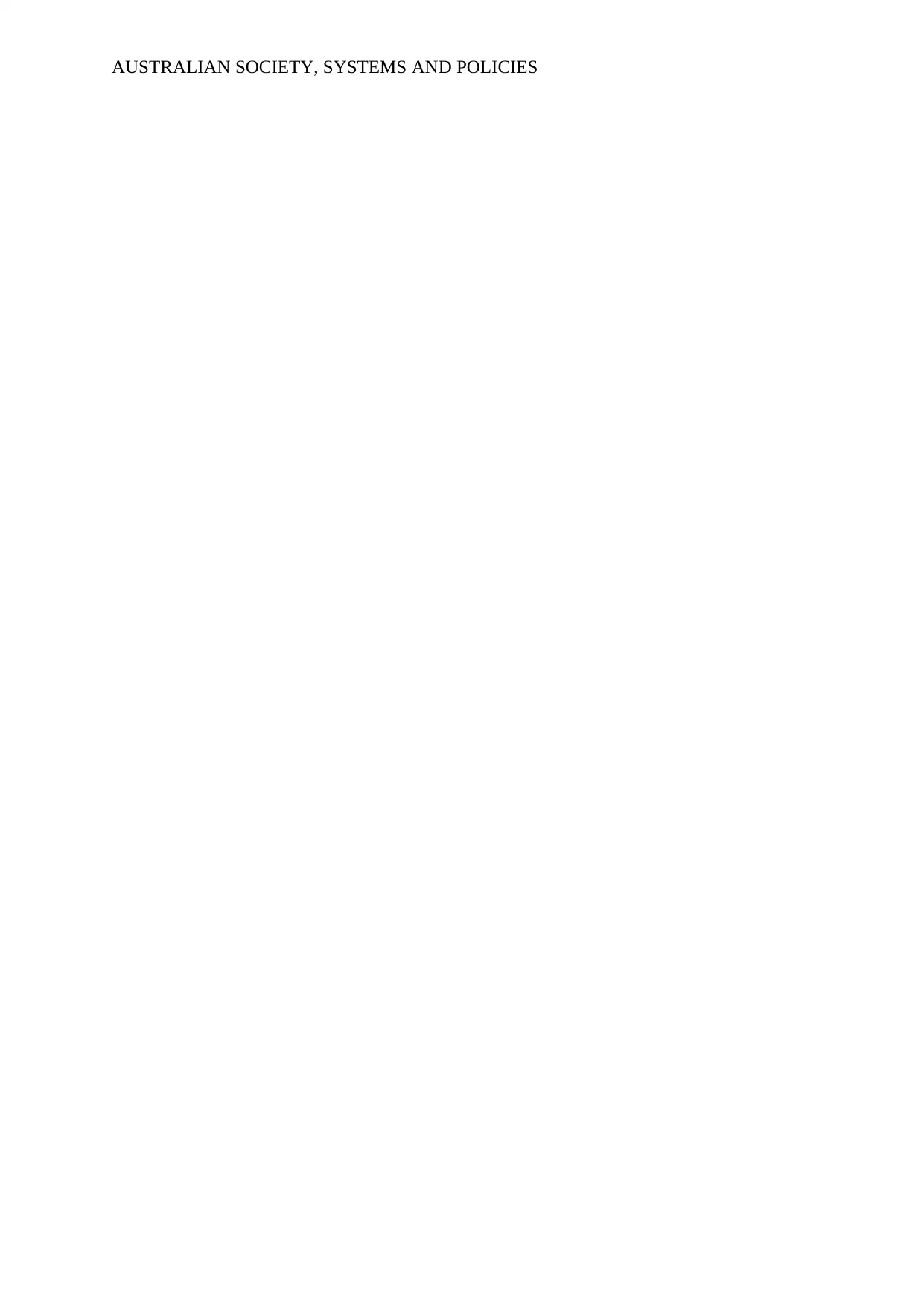
AUSTRALIAN SOCIETY, SYSTEMS AND POLICIES
⊘ This is a preview!⊘
Do you want full access?
Subscribe today to unlock all pages.

Trusted by 1+ million students worldwide
1 out of 9
Related Documents
Your All-in-One AI-Powered Toolkit for Academic Success.
+13062052269
info@desklib.com
Available 24*7 on WhatsApp / Email
![[object Object]](/_next/static/media/star-bottom.7253800d.svg)
Unlock your academic potential
Copyright © 2020–2025 A2Z Services. All Rights Reserved. Developed and managed by ZUCOL.





